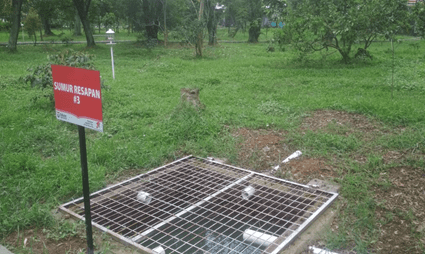Telkom University, sebagai salah satu institusi pendidikan terkemuka di Indonesia, telah mengambil langkah proaktif dalam menjaga keberlanjutan lingkungan melalui implementasi sumur resapan. Berlokasi di tengah kota yang berkembang pesat, kampus ini menghadapi tantangan dalam pengelolaan air, terutama saat musim hujan. Sumur resapan menjadi solusi inovatif untuk mengatasi masalah ini.
Lokasi Strategis dan Fungsi Utama
Sumur resapan di Telkom University terletak di sebelah Gedung Bangkit, salah satu landmark utama kampus. Lokasi ini dipilih untuk mengoptimalkan fungsi sumur dalam menangkap aliran permukaan air hujan. Dengan menyerap air hujan ke dalam tanah, sumur resapan berfungsi sebagai “filter” alami yang mencegah genangan air dan potensi banjir di area kampus.
Infiltrasi adalah proses peresapan air ke dalam tanah melalui celah-celah permukaan tanah. Dalam konteks ini, sumur resapan berperan sebagai infiltrator yang mempercepat proses infiltrasi air hujan ke dalam lapisan tanah yang lebih dalam. Dengan demikian, risiko genangan air atau banjir dapat diminimalkan.
Mencegah Banjir dan Menjaga Kualitas Air Tanah
Salah satu fungsi utama sumur resapan adalah mencegah banjir dengan menyimpan aliran permukaan air. Dalam lingkungan perkotaan yang padat seperti Telkom University, pengelolaan air hujan menjadi sangat penting. Infiltrasi adalah langkah kunci dalam pengelolaan air hujan, di mana air yang diserap oleh tanah membantu meringankan beban saluran pembuangan.
Selain itu, sumur resapan juga berperan dalam menjaga tinggi muka air tanah. Dengan memperlambat aliran air permukaan, sumur ini meningkatkan cadangan air tanah dan membantu mengurangi polusi. Proses infiltrasi yang berkelanjutan ini sangat penting untuk menjaga kualitas ekosistem di sekitar kampus.
Konservasi Air dan Sistem Pengelolaan Lingkungan
Telkom University telah mengembangkan sistem konservasi air yang komprehensif dengan memasang sumur resapan di setiap bangunan. Tujuannya adalah mencegah air hujan langsung mengalir ke saluran pembuangan, tetapi dapat meresap ke dalam tanah dalam volume yang lebih besar. Sistem ini memastikan bahwa proses infiltrasi adalah cara yang efektif untuk menjaga keseimbangan hidrologi lokal. Selain sumur resapan, kampus juga memiliki sistem penyaringan air yang memastikan air yang masuk ke Danau Situ Tekno bersih dari kotoran.
Dampak Positif terhadap Kesadaran Lingkungan
Implementasi sumur resapan di Telkom University bukan hanya infrastruktur fisik; ini juga mencerminkan komitmen kampus terhadap keberlanjutan lingkungan. Kehadiran sumur resapan menginspirasi mahasiswa dan staf untuk lebih peduli terhadap isu lingkungan. Sebagai contoh, mereka dapat memahami bahwa infiltrator seperti sumur resapan memainkan peran penting dalam mendukung pelestarian sumber daya alam melalui proses infiltrasi yang efisien.
Kesimpulan
Dengan langkah-langkah inovatif seperti pembangunan sumur resapan, Telkom University menunjukkan bahwa pendidikan tinggi dapat berperan aktif dalam konservasi lingkungan. Melalui pengelolaan sumber daya air yang baik dan kesadaran lingkungan yang tinggi, kampus ini tidak hanya menciptakan lingkungan belajar yang nyaman tetapi juga berkontribusi pada keberlanjutan ekosistem secara keseluruhan.
Infiltrasi adalah salah satu cara paling efektif untuk mengelola air hujan di lingkungan perkotaan yang padat. Dengan memanfaatkan sumur resapan sebagai infiltrator utama, Telkom University telah menciptakan solusi praktis yang memberikan manfaat jangka panjang bagi lingkungan dan


Leave a Reply